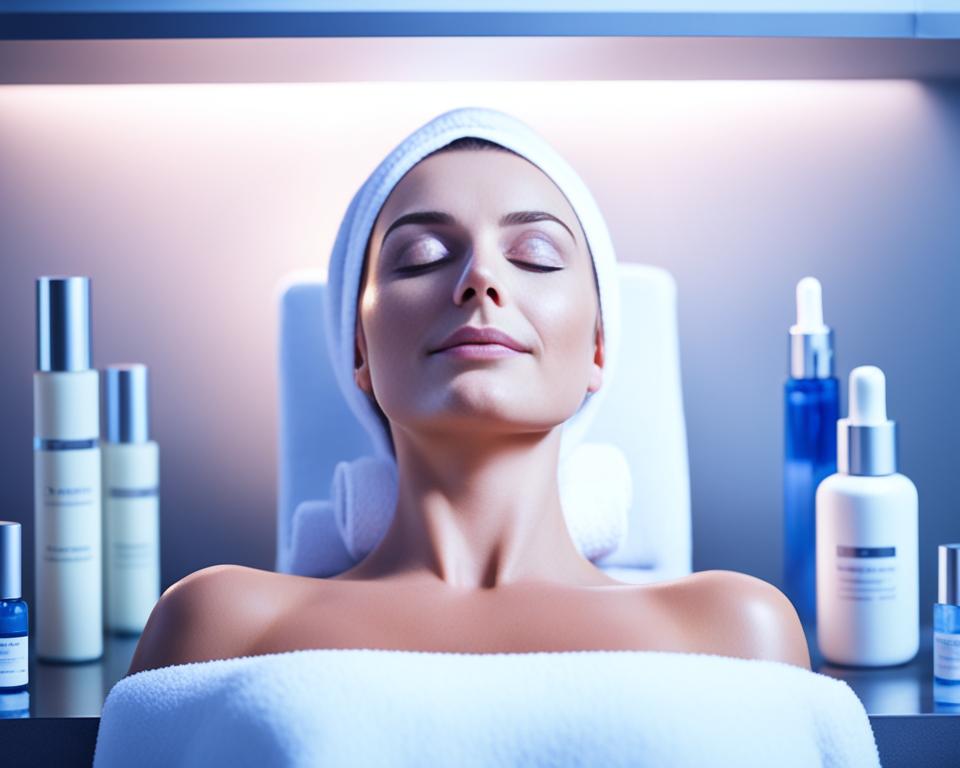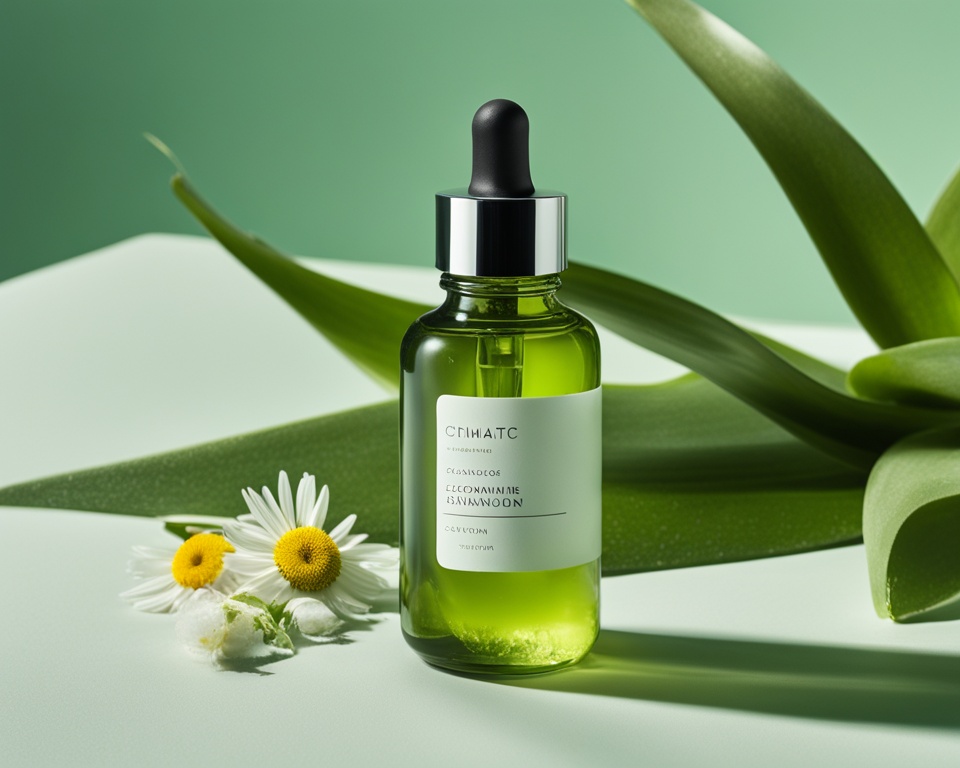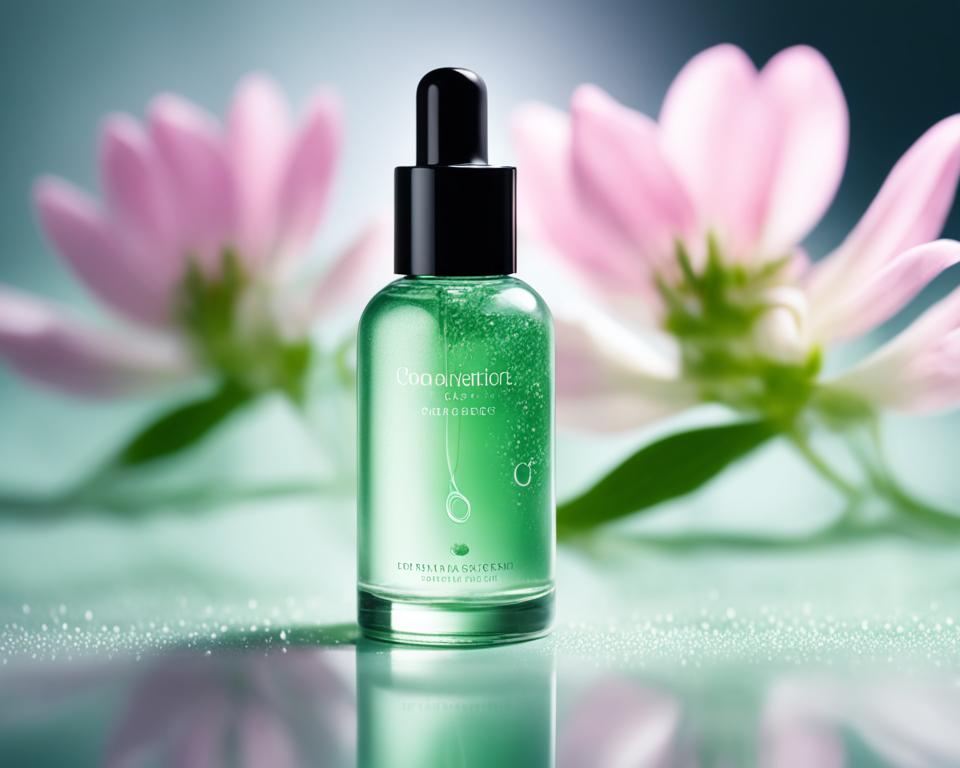Do you often deal with skin redness? You’re not the only one. Dealing with red skin can be tough, but the right anti redness serum can help. This guide will show you the best ways to reduce skin redness, whether it’s from rosacea, sensitivity, or after a procedure.
We’ll look into what causes skin redness and why using an anti redness serum is good for you. You’ll learn how to pick the right product for your skin type and concerns. We’ll cover calming face serums, other skincare products, and lifestyle tips for a glowing complexion.
With these anti redness serum solutions, you can say hello to a clear complexion. Get ready to enjoy the calming effects that will make your skin look refreshed and renewed.
Read more interesting information at ::thekitchenbookstore
Understanding Skin Redness
Skin redness can be frustrating and unsightly. It has many possible causes. Knowing what causes and shows skin redness helps find good solutions.
Causes and Symptoms
Sun exposure is a common cause of skin redness. Too much sun can cause sunburn and inflammation, making the skin red and irritated. Some skincare products, medicines, or environmental factors can also make the skin red, itchy, and inflamed.
Inflammatory skin disorders like rosacea can lead to ongoing skin redness. Rosacea brings flushing, visible blood vessels, and a red, sensitive look. It often hits the cheeks, nose, and forehead.
Sensitivity and Inflammation
People with sensitive skin often face more skin redness. Skin inflammation from things outside or an underlying issue can make redness and discomfort worse.
“Reducing skin inflammation is key to soothing redness and restoring a healthy, glowing complexion.”
Knowing the common causes and signs of skin redness helps you take steps to fix it. This way, you can get your skin back to its healthy, glowing state.
Benefits of Anti Redness Serums
Using an anti-inflammatory skincare product like an anti-redness serum has many benefits. These products are made to lessen inflammation, improve skin function, and make your skin look more even. They help soothe and calm irritated skin.
One big plus of an anti-redness serum is how it reduces redness and irritation. These serums have ingredients that calm the skin. They lessen redness and inflammation.
Anti-redness serums also help make your skin less sensitive. They strengthen your skin’s barrier. This keeps irritants from causing more trouble.
Using an anti-redness serum regularly is good for your skin’s health. It works on the root causes of redness. This leads to a skin that looks balanced and radiant.
“Anti-redness serums offer a comprehensive solution for soothing and calming irritated skin, providing both immediate and long-term benefits for a healthier, more resilient complexion.”
If you often get red skin or have ongoing redness, adding an anti-redness serum to your skincare can change things. It’s a step towards a balanced, glowing complexion.
Choosing the Right Anti Redness Serum
Choosing the right anti-redness serum can really help soothe your skin. It’s key to know the ingredients and types of formulations that tackle skin irritation and inflammation. This knowledge helps you pick the best product for your skin.
Ingredients to Look For
Top anti-redness serums have calming botanicals, antioxidants, and anti-inflammatory compounds. Look for green tea, niacinamide, vitamin C, centella, and ceramides. These ingredients help lessen redness, soothe sensitivity, and protect the skin.
Formulation Types
- Serums: Lightweight, concentrated formulas that target specific skin concerns, including redness and inflammation.
- Gels: Oil-free, hydrating textures that can provide a refreshing, soothing effect on the skin.
- Concentrates: Highly potent formulations that deliver a powerful dose of active ingredients to visibly calm and reduce redness.
Think about your skin type and its needs when picking an anti-redness serum. If you have oily or acne-prone skin, a gel might be best. For dry or sensitive skin, a serum or concentrate with more hydration could be better.
“The key to finding the right anti-redness serum is to pay attention to the specific ingredients that can calm and soothe your skin, while also addressing the underlying causes of your skin concerns.”
Knowing the key ingredients and types of anti-redness serums helps you make a smart choice. You can pick a product that meets your skin’s specific needs.
Top Picks: Best Anti Redness Serums
Finding the right anti-redness serums can be tough, but there are great options out there. We’ll share some top picks that skincare experts and users love.
The Calming Serum by Dermalogica is a great choice. It’s made with plants and helps lessen redness. With aloe vera and licorice root, it calms the skin and builds up its natural barrier.
The Redness Relief Serum from SkinCeuticals is another excellent choice. It’s proven to work and targets redness at its source. With vitamin C and ferulic acid, it reduces redness and makes your skin look even and bright.
| Product | Key Ingredients | Benefit | Customer Rating |
|---|---|---|---|
| Calming Serum by Dermalogica | Aloe vera, licorice root extract | Soothes inflammation and redness | 4.7/5 |
| Redness Relief Serum from SkinCeuticals | Vitamin C, ferulic acid | Minimizes the appearance of redness and flushing | 4.5/5 |
| Redness Neutralizing Serum by La Prairie | Botanical extracts, hyaluronic acid | Visibly reduces redness and sensitivity | 4.9/5 |
If you want something luxurious, try the Redness Neutralizing Serum by La Prairie. It has botanicals and hyaluronic acid to lessen redness and irritation. Skincare lovers praise it for its soothing effects.
No matter your skin type or redness issues, these serums can help. Add one to your daily skincare and see how it changes your look. You’ll get a calmer, brighter complexion.
How to Incorporate an Anti Redness Serum into Your Routine
Adding an anti-redness serum to your skincare routine can really help soothe and calm irritated skin. Here are some tips to make the most of your serum:
Application Tips
Begin by washing your face and letting it dry. Then, put a few drops of the serum on your fingertips. Gently massage it into your skin, especially where redness often shows up, like the cheeks, nose, and chin.
For the best effect, put the serum on before moisturizing. This lets the ingredients sink in deeply. Be gentle when applying – don’t rub or pull your skin, as this can make redness worse.
If you’re using other skincare products, like a vitamin C serum or retinol, put the anti-redness serum on first. Then, add the other products. This way, the anti-redness serum can work well without being covered up by stronger products.
Using an anti-redness serum regularly is important. Try to add it to your morning and evening skincare routines. With regular use, you should see less redness and irritation over time.
Complementary Skincare Products
An anti-redness serum is great for soothing skin, but pairing it with other products can help even more. These products work well with your redness reducing skincare. They support your skin’s health and look.
Here are some skincare products for redness that go well with an anti-redness serum:
- Gentle Cleansers: Pick a redness reducing skincare cleanser without harsh stuff like sulfates. It should keep your skin’s natural oils. Look for ones with calming stuff like chamomile or aloe vera.
- Calming Toners: Use a toner to balance your skin’s pH and add moisture. Ingredients like rose water or green tea calm and lessen redness.
- Moisturizing Creams: Match your anti-redness serum with a moisturizer that’s fragrance-free and won’t clog pores. It should keep your skin hydrated for a long time.
- Soothing Masks: Try a gentle, clay-based mask or a hydrating sheet mask once or twice a week. They deeply nourish and calm your skin.
Being consistent with skincare products for redness is important. Adding these products to your daily routine boosts your redness reducing skincare. It leads to healthier, glowing skin.
Lifestyle Factors for Reducing Redness
Targeted skincare products can help manage skin redness, but your lifestyle matters too. Adjusting your diet and stress levels can support your skin’s healing. This can lessen redness.
Diet and Skin Redness
What you eat affects your skin and inflammation. To fight redness, eat foods that reduce inflammation. Omega-3 fatty acids in salmon, walnuts, and flaxseeds calm irritated skin. Berries, leafy greens, and bell peppers are full of antioxidants that help reduce redness and improve skin health.
Stress Management for Redness
Stress can make skin red and inflamed. High stress levels release compounds that worsen skin issues. To help, try meditation, deep breathing, or yoga. Also, getting enough sleep and staying active can lessen skin redness.
| Dietary Factors for Reducing Redness | Stress Management Techniques for Redness |
|---|---|
|
|
Choosing a lifestyle that supports your skin can help reduce redness. This leads to a more radiant and even-toned complexion.
Anti Redness Serum for Specific Concerns
Anti-redness serums help many skin types and concerns. They are great for rosacea and skin irritation after procedures. These serums have special ingredients to fight redness, inflammation, and sensitivity.
Rosacea Relief
Rosacea makes your face red, flush, and irritated. An anti redness serum for rosacea can really help. It should have calming stuff like green tea, chamomile, and centella. These ingredients soothe inflammation and lessen redness.
Post-Procedure Healing
After treatments like microneedling or laser, your skin might be red and sensitive. An anti redness serum for post-procedure skin can help. It has ingredients like vitamin C, hyaluronic acid, and ceramides. These help calm the skin, lessen irritation, and support its natural barrier.
| Ingredient | Benefits for Rosacea | Benefits for Post-Procedure Skin |
|---|---|---|
| Green Tea | Calms inflammation, reduces redness | Antioxidant properties, soothing |
| Centella Asiatica | Strengthens skin barrier, reduces irritation | Promotes wound healing, calms inflammation |
| Vitamin C | Brightens complexion, improves skin tone | Stimulates collagen production, aids in healing |
| Hyaluronic Acid | Deeply hydrates, plumps the skin | Retains moisture, supports skin barrier |
Using an anti redness serum for rosacea or an anti redness serum for post-procedure skin in your routine can help. You can get rid of specific concerns and have calmer, more radiant skin.
Professional Treatments for Persistent Redness
For those with stubborn or severe skin redness, at-home remedies might not be enough. Professional help can offer better relief. Options like laser therapy, chemical peels, and other medical treatments can help with long-lasting results.
Laser therapy is a top choice for professional treatments for skin redness. It uses light energy to fix the root causes of redness, like broken blood vessels or inflammation. This can make redness less visible, improve skin texture, and give a healthier look.
Chemical peels are another great option for in-clinic redness treatments. They use special chemicals to remove dead skin, showing off smoother skin. Some peels, with ingredients like salicylic acid or lactic acid, can lessen redness by fighting inflammation and boosting skin health.
Dermatologists might suggest other treatments too, like light therapy, cryotherapy, or strong creams. These are made for your specific skin issues and can work better than what you can buy over the counter.
Remember, while home remedies are good for mild redness, seeing a dermatologist is best for serious cases. They can find and fix the real causes of redness, offering a lasting solution for clear skin.

DIY Anti Redness Serum Recipes
For those looking for a personalized way to reduce skin redness, making your own DIY anti redness serum is a great option. It’s both affordable and tailored to your skin’s needs. You can use common ingredients that are good for your skin to make a special formula.
Here are some easy DIY anti redness serum recipes you can try at home:
- Soothing Aloe Vera Serum: Mix 1/4 cup of fresh aloe vera gel with 2 tablespoons of rosewater and 5 drops of chamomile essential oil. Apply it on clean skin, especially where it’s red.
- Calming Green Tea Serum: Soak 2 green tea bags in 1/4 cup of boiling water, let it cool, then mix in 1 tablespoon of glycerin and 3 drops of lavender essential oil. Rub this serum on your skin to lessen inflammation.
- Soothing Oatmeal Serum: Combine 1/2 cup of ground oatmeal with 2 tablespoons of raw honey and 1 tablespoon of jojoba oil. Put it on the red areas to soothe and calm your skin.
When making your own anti redness serum, always test it on a small area first. This ensures it won’t irritate your skin or make it redder. Start with small amounts and adjust as needed for your skin type.
“Homemade anti redness serums can be a game-changer for those seeking a more personalized approach to managing skin redness.”
Adding a DIY anti redness serum to your skincare can be both helpful and save money. Try out different natural ingredients to find the best mix for your skin’s needs.
The Science Behind Anti Redness Serums
Exploring the science of anti-redness serums helps us see how they work to calm irritated skin. These products use a mix of active ingredients. They work together to fix the main issues of skin redness and sensitivity.
Ingredients and Mechanisms of Action
Key ingredients in anti-redness serums include green tea, chamomile, and centella asiatica. These plants have anti-inflammatory effects. They help lessen redness, swelling, and discomfort. Some serums also have vitamin C or niacinamide. These add to the skin’s barrier strength and help it look healthier.
Clinical Studies and Research
Many studies show that anti-redness serums work well for different skin issues. A study in the Journal of Dermatological Treatment found a serum with green tea extract and bisabolol helped reduce redness in sensitive skin. Another study in the Journal of Cosmetic Dermatology showed a serum with centella asiatica improved skin barrier function and lowered inflammation.
“The science behind anti-redness serums is truly remarkable, with clinical evidence supporting their ability to soothe and calm even the most sensitive of skin types.”
As research grows, we learn more about anti-redness serums. This knowledge gives people effective ways to handle skin redness and irritation.
Anti Redness Serum FAQs
Many people wonder about using anti-redness serums to calm their skin. We’ll answer some common questions to help you pick the right one for your skin.
What are the key ingredients in effective anti-redness serums?
Look for serums with vitamin C, niacinamide, green tea, and centella asiatica. These ingredients help reduce inflammation and soothe irritation. They also make the skin stronger.
How often should I use an anti-redness serum?
Experts suggest using an anti-redness serum 1-2 times a day. You can use it in the morning, evening, or both. Start with once a day and increase as needed.
Will an anti-redness serum treat the root cause of my skin redness?
Anti-redness serums can help right away and over time. But they might not fix the deep cause of redness, like rosacea or sensitivity. For ongoing issues, see a dermatologist.
| Common Questions about Anti Redness Serums | Answers |
|---|---|
| Can anti-redness serums be used by all skin types? | Yes, most anti-redness serums are gentle and work for many skin types, even sensitive skin. |
| How long does it take to see results from an anti-redness serum? | People often see less redness and irritation in 2-4 weeks with regular use. Results can differ from person to person. |
| Are there any side effects to using an anti-redness serum? | Most people find anti-redness serums safe, but some might feel dryness or tingling at first. Always test a small area before using it all over. |
Knowing these questions and answers helps you pick the right anti-redness serum. This way, you can find relief for your skin concerns.

Conclusion
As we wrap up our look at anti-redness serums, it’s clear they can change the game for those with red, inflamed skin. These serums tackle the root causes of redness, like sensitivity or environmental damage. They soothe and calm the skin, making it look more radiant and balanced.
Choosing the right serum is key. Look for ones with ingredients like vitamin C, niacinamide, and soothing plants. These can help fight redness and make your skin look healthier and more even. Adding an anti-redness serum to your daily skincare routine can make a big difference.
Getting rid of redness is a journey that needs a mix of the right products and a healthy lifestyle. With the right knowledge and products, you can improve your skin’s health and get the glowing skin you want. So, try using anti-redness serums and start on a path to clearer, more confident skin.






